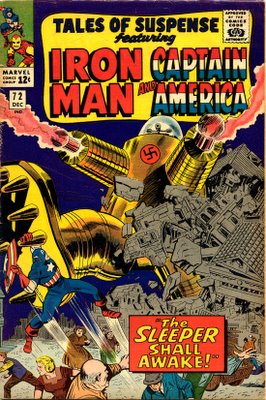In the early 1960s, Marvel Comics had become something of a joke. They published a small line of magazines that mostly featured monsters with names like Fin Fang Foom or Shagg or Shamoo. But Stan Lee, the writer and editor for most of Marvel's stories noticed the superhero revival going on at DC Comics and decided to copy it. The first attempt was the Fantastic Four, a team title that was something of a knockoff of DC's Justice League of America.
The first issue told the origin of the team. The FF was made up of four characters who had travelled in a space ship to the radiation belt surrounding the Earth. The radiation caused strange mutations to the four. Reed Richards, the scientific genius leading the team, developed the power of stretchability, much like Plastic Man and the Elongated Man. Ben Grimm, a test pilot, turned into the super-strong (and super-ugly) Thing. Sue Storm, Reed's girlfriend, turned invisible, while Johnny Storm, her younger brother, burst into flame as the Human Torch.
The use of radiation as an origin device was new as far as I know, although Marvel would use it several more times in the next few years. Spider-Man, Daredevil and the Hulk would all see their powers result from exposure to radiation in one way or another.
The other novelty of the Fantastic Four was that the members were not "all for one and one for all". They bickered among themselves, especially Ben, who blamed Reed for his transformation into the homely Thing.
More about →
The first issue told the origin of the team. The FF was made up of four characters who had travelled in a space ship to the radiation belt surrounding the Earth. The radiation caused strange mutations to the four. Reed Richards, the scientific genius leading the team, developed the power of stretchability, much like Plastic Man and the Elongated Man. Ben Grimm, a test pilot, turned into the super-strong (and super-ugly) Thing. Sue Storm, Reed's girlfriend, turned invisible, while Johnny Storm, her younger brother, burst into flame as the Human Torch.
The use of radiation as an origin device was new as far as I know, although Marvel would use it several more times in the next few years. Spider-Man, Daredevil and the Hulk would all see their powers result from exposure to radiation in one way or another.
The other novelty of the Fantastic Four was that the members were not "all for one and one for all". They bickered among themselves, especially Ben, who blamed Reed for his transformation into the homely Thing.












